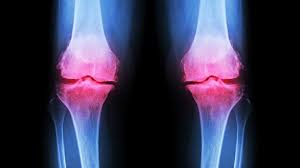Table of Contents

Osteoarthritis is a chronic arthropathy (A disease of the joint) characterized by the degeneration of cartilage and also by hypertrophy (increase in bulk as by thickening of the muscle fibers) of the bones and articular axis.
In osteoarthritis, there is minimum inflammation and the mechanical factors involved in its pathogenesis may vary.
The major symptoms that are felt in osteoarthritis are pains in the phalangeal joints.
There are two divisions of osteoarthritis;
1. Primary osteoarthritis
2. Secondary Osteoarthritis.
PRIMARY OSTEOARTHRITIS:
In primary Osteoarthritis, the joints most affected are the terminal interphalangeal joints and the proximal interphalangeal joints (to a lesser extent).
It also affects the metacarpophalangeal and carpophalangeal joints of the thumb, hip, big toe, and parts of the lumbar and cervical spine.
SECONDARY OSTEOARTHRITIS:
Secondary osteoarthritis occurs in any joint. It occurs after an articular injury resulting from Variable causes.
This injury may be acute such as a fracture or a dislocation, third-degree burns.
It might also be chronic such as the injuries caused by overweight, diabetes, excessive overuse of the joints due to a job, and other injuries caused by chronic conditions.
Inflammation rarely occurs In Osteoarthritis, if it occurs it is usually minimal.
The only condition where Osteoarthritis is very noticeable is in acute interphalangeal osteoarthritis in which a lot of joints are affected even the joints in the fingers
CLINICAL PRESENTATION
The primary target here is the cartilage, cartilage damage should be discovered, swellings, pains, etc.
Secondary events such as:
1. Destroying of the cartilage
2. Sclerosis: This is a pathological condition in which the cartilaginous tissues become very hard due to overgrowth of fibrous tissues or interstitial tissues and other changes.
3. Osteocytes pore formation: Formation of osteocytes in the cells of the bones can lead to weakened bones and bone fracture.
4. Pain
5. Swelling
6. Joint narrowing due to the increase in swelling.
7. Chronic conditions such as contraction of the joint.
RISK FACTORS
1. Genetic factors: A person is likely to develop Osteoarthritis if the disease runs in the family.
2. Age: Osteoarthritis majorly affects older people from age 45 and above.
3. Gender: For no obvious reason, osteoarthritis affects females more than it affects males
4. Joint injuries: Joint injuries caused by physical activity, Mechanical trauma such as accidents, intense sports can precipitate the development of Osteoarthritis.
5. Overweight: People with excess weight can easily develop Osteoarthritis, because this excess weight rests on the joints, putting extra pressure on the joints, this can lead to intense pain and can progress into osteoarthritis.
6. Having weak thigh muscles.
7. Injection of Analgesic: Studies have shown that some analgesics such as some high-grade sedatives and some non-steroidal anti-inflammatory agents can increase the risk of developing osteoarthritis, especially if injected.
SIGNS AND SYMPTOMS
1. PAIN: Pain is the first obvious symptom of Osteoarthritis is pain. This pain is usually felt in the joint during use or after use, and sometimes it is felt after a long period of rest/inactivity.
2. JOINT FLEXIBILITY: The joint becomes less flexible, small movements can cause severe pains. This reduction in joint flexibility is due to the damaged cartilages.
3. There is usually this feeling of numbness/discomfort in the joints when there is a change in weather, usually from dry to cold weather.
4. HEAT: There is usually an increased temperature in the affected joints. This is a bodily response to the damaged cartilages. The blood flows to that area increases and since heat energy is transferred in the blood, the concentration of blood there causes heat.
5. Swelling and stiffness of the affected joints.
6. Bony lumps on the base of the affected fingers, or the base of the thumb.
MODIFICATIONS THROUGH EXERCISE.
Obesity can be reduced through moderate exercise, and this can have a limiting effect on the progression of Osteoarthritis.
Exercises can also reduce the friction of the joints and depression felt by the patient.
Exercise strengthens the muscles of the thighs and thus reduces the risk factor that a weak thigh causes.
The exercise should not be too stressful and should be adequately monitored. The exercise should be immediately discontinued at a slight discovery of pain.
Other alternative medical procedures like Acupuncture, Copper jewelry, Homeopathy, Magnets, etc have been found useful in managing Osteoarthritis.
NON PHARMACOLOGICAL APPROACH TO THE MANAGEMENT OF OSTEOARTHRITIS.
1.Patient education
2. Self-management.
3. Rest
5. Diet
6. Exercise.
7. Damage control.
8. Physical and occupational therapy, Etc.
The patient should;
1. Use assistive devices such as alarms, to remember the right times for exercise, take drugs, physiotherapy, etc.
2. Know limits when exercising.
3. Rest.
4. Make use of the strongest muscle.
5. Most importantly keep a positive attitude.
ROLE OF A HEALTH CARE PROFESSIONAL
1. Assessing treatment plan, drug prescription, drug dispensing, and monitoring drug use.
2. Patient education and counseling.
3. Team player.
4. Patient advocate.
ALSO READ:
Distinguishing Libel from Slander: Key Contrasts
Glo Recruitment 2023/2024: Apply and Check Requirements
JAMB RUNZ and JAMB 2020 EXPO for Biology | LIKELY Biology Questions
Leave a Reply